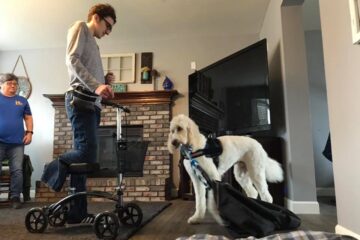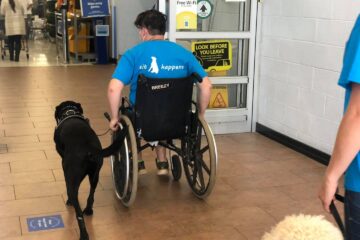At Highland Canine Service Dogs, we have had the privilege of training service dogs to perform a wide variety of tasks. From service dogs trained to assist children diagnosed with autism, to mobility service dogs who help people who struggle with movement, there seems to be no limit to the way service dogs can enhance the lives of those who require them.
One less common – yet incredibly valuable – type of service dog is the seizure service dog. Epilepsy is the fourth most common neurological disease after migraines, strokes and Alzheimer’s. It affects over 65 million people around the world, and it is estimated that one in 26 Americans will develop epilepsy during the course of their lives.
Given the prevalence of seizures and the effect they can have on those who suffer them, any tool that can be used to improve quality of life is important. That’s where the seizure service dog comes into the picture – performing vital tasks that can improve independence, sleep quality and peace of mind.
Within the realm of seizure service dogs, there are two distinct types – the seizure alert dog and the seizure response dog. Although both are trained to help those who suffer with seizures, there are some notable differences between the training process for each type of seizure service dog. In this article, we’ll look at those differences and outline the types of tasks each dog can be trained to perform.
What is the difference between seizure alert and seizure response dogs?
The main difference between these two types of service dogs is the function they perform for their handler – which influences the tasks they carry out.
Although both types of dogs are trained to perform certain tasks when a seizure occurs, a seizure alert dog is trained to react prior to a seizure actually occurring. Dogs are very perceptive to changes in human behavior – this includes physical changes, breathing patterns, or the way a human’s odor profile changes. A seizure alert service dog can be trained to recognize these signs and respond accordingly.
A seizure response dog is trained to respond to a seizure in a specific way. For example, the dog may be trained to respond by barking to alert other family members; performing deep pressure therapy to calm and prevent injury; or retrieving a medicine bag which contains medication to help alleviate the symptoms. This is different to an alert dog, who performs their task before the seizure takes place; the response dog is used to react to a seizure.

How to train a seizure alert dog
It is important to state – before we get into the process for training a seizure alert dog – that dogs cannot alert to every types of seizure. The process can only succeed if there are unique behaviors that the dog can identify and react to – for example, a physical, visual or audible cue that is easily noticed by the dog.
It is generally easier to train a seizure alert dog for Grand Mal, myoclonic, clonic and tonic seizures, as the epileptic episode typically has distinctive cues that the dog can react to. By contrast, atonic and absence seizures often do not show physical or audible body reactions, meaning it is much more difficult to train a dog to anticipate the seizure.
Those unique cues are built into the training process. As with any service animal, the dog is taught a solid foundation of obedience and socialization, after which the task training begins. This involves training the dog by exposing them to the symptoms of the seizure; from there, the dog will be trained to perform its desired task, such as barking to alert other family members or engaging in deep pressure therapy (DPT) to calm and reduce the chance of injury. The dog is rewarded when successfully completing the behavior.
This process continues over a long period of time – in different environments and in the presence of distractions – to build a solid response in the service dog. Repetition is absolutely pivotal to ensure the behavior is reliable and the dog reacts as anticipated when a seizure is oncoming.
How to train a seizure response dog
Training a dog to respond to a seizure is usually a little easier than alerting in advance. This is because when an individual is in the midst of a seizure, there are usually more obvious cues for the dog to pick up on.
Again, it is important to have a basis of obedience and socialization to ensure that the service dog is capable of performing reliably in all situations. From there, the dog will be exposed to the common behaviors taking place during the seizure, and be taught to respond to them by performing a particular task. The task could range from pressing a medical button with their paw to alert other members of the household, retrieving a bag with medication from another part of the room or home, or providing physical stimulation by laying on the individual who is suffering the seizure.
A seizure response dog is not only a valuable tool for the epileptic individual themselves; they also provide reassurance and peace of mind for other members of the household. Many families cite the presence of a seizure response dog with improved sleep quality, as they no longer have to worry if their child is in a different room and have a seizure without their knowledge. A dog with a bark alert or pressing a medical alert device can notify them if a seizure is taking place, ensuring they can arrive and help as necessary.

In conclusion
The process of training a service dog to help an individual suffering with seizures – whether for an alert function in advance of a seizure taking place, or in response to one – takes time, effort and skill to ensure reliability. As with lots of aspects of dog training, timing is of fundamental importance. Good timing ensures the dog is able to perform their given task reliably and successfully in every situation.
If you have questions about seizure service dogs and their training process, or would like more information on the seizure service dogs we provide, we’d love to hear from you! Please get in contact with us via our website form or calling (704) 500-8281.



0 Comments